The monthly Consumer Price Index had no change for November as the price of gas declined. CPI measures inflation, or price increases. While overall inflation was unchanged, consumers still did not get a break for the cost of sheltering oneself rose dramatically.
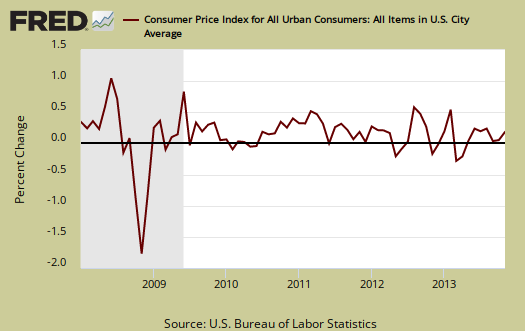
CPI has only increased 1.2% from a year ago as shown in the below graph. This is a very low annual rate of inflation and believe this or not, deflation can really harm an economy.

Core inflation, or CPI with all food and energy items removed from the index, increased 0.2%. Core inflation has risen 1.7% for the last year and since June 2011 has ranged from 1.6% to 2.3%. Core CPI is one of the Federal Reserve inflation watch numbers and 2.0% per year is their boundary figure. Graphed below is the core inflation change from a year ago.

Core CPI's monthly percentage change is graphed below.
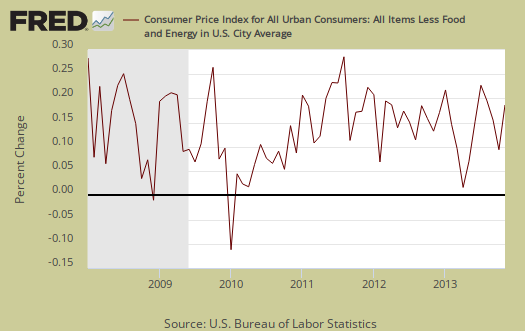
Energy overall declined -1.0% and energy costs are now down -2.4% for the entire year. The BLS separates out all energy costs and puts them together into one index. This index includes gasoline which dropped -1.6% for the month and has declined -5.8% for the year. Natural gas is now up 1.0% from a year ago after a monthly decline of -1.8%. Energy costs are also mixed in with other indexes, such as heating oil for the housing index and gas for the transportation index. Below is the overall CPI energy index, or all things energy.

Graphed below is the CPI gasoline index only, which shows the volatility of gas prices. This isn't the first time, nor will it be the last, where the monthly inflation numbers move dramatically on gas prices and what percentage this is of the monthly budget varies widely among consumers.

Core inflation's components include shelter, transportation, medical care and anything not food or energy. The shelter index is comprised of rent, the equivalent cost of owning a home, hotels and motels. Shelter increased 0.3% and is up 2.4% for the year. This is the highest monthly shelter inflation increase since July 2011. Rent increased 0.2%, but the cost for home owners increased 0.3% as well. Hotels and Motels, known as lodging away from home ballooned back up after last month's nosedived, by 2.9% in a month. Graphed below is rent, where cost increases hits the people who can least afford it.
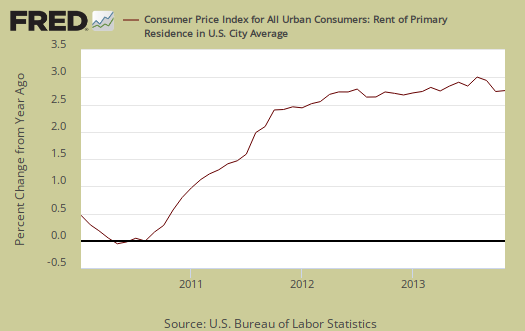
A core inflation cost which almost never drops is medical care. Medical care was unchanged this month, the 2nd month in a row, and even prescription drugs did not increase this month. The Medical care index has increased 2.2% over the last 12 months. Graphed below is the overall medical care index change from a year ago.
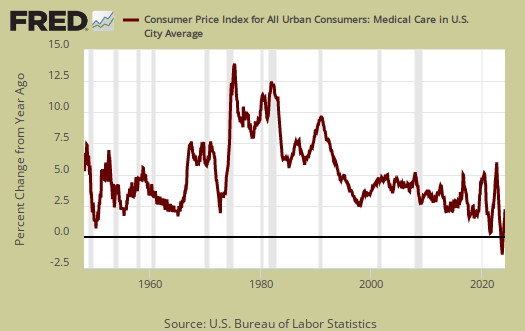
Below is a graph of the medical commodities index, which in large part consists of prescription drug prices and had no change, a rarity, for this month. Notice the beyond belief never ending increases since 1975. With all of the TV ads for overpriced, cancer risk side effect drugs running full stop every 7 minutes, don't expect prescription drugs price decreases to last. Big Pharma's marketing costs have to be obscene and those costs are passed onto the American consumer.
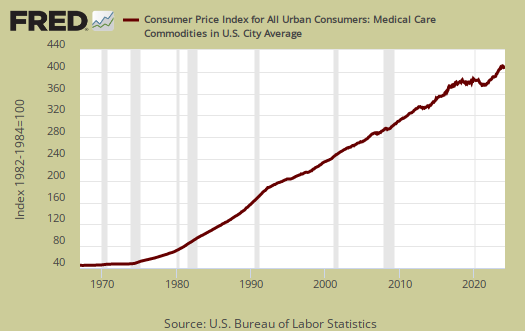
Food and beverages overall increased 0.1% and have increased 1.2% from a year ago. The food at home index, i.e. groceries, had no change for the month. Food for home is now the lowest annual increase since June 2010, up 0.6% for the year.. Eating out, or food away from home increased 0.3% from last month and is up 2.1% from a year ago. Graphed below is the overall food index.
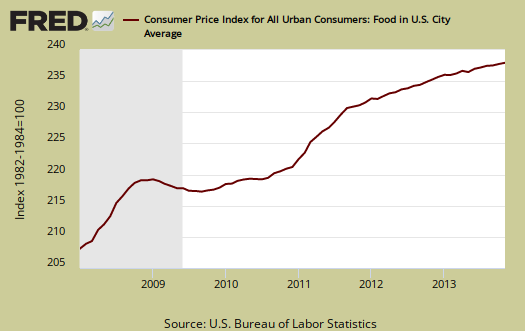
Graphed below is the food at home index. CPI does numerous substitutions on food, where if the price of steak increases, they claim hamburger is equivalent. Substitutions in part explain why you see $7 for some crappy frozen take out at the grocery, yet the food index rise appears relatively tame. We must wonder if the BLS believes people can switch to cereal from meat now. Don't think one just got a break at the grocery. The reason food at home declined by -1.8% for the year is non-alcoholic beverages . That's right, your high fructose corn syrup, carbonated, empty nutrition water just got cheaper.
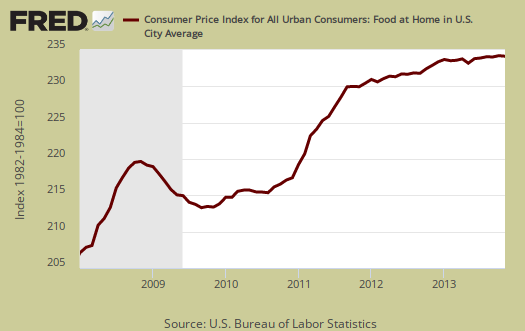
While inflation is tame, shelter is on the rise and this is 31.8% of monthly expenditures. Additionally the BLS released real hourly earnings for November. The hourly real wage increased 0.2% and has increased 0.9% for the year. This means wages are just barely keeping up with inflation.
CPI details
The DOL/BLS does take yearly surveys on where the money goes in the monthly budget, but as one can see, food and energy are significant amounts of the monthly finances. Run away costs in these two areas can break the bank, so can food. Additionally CPI uses substitution, so if flour goes through the roof, somehow we're all just fine with oats and prices didn't really overall increase much. Here is the BLS CPI site, where one can find much more details, information on calculation methods and error margins.
Other CPI report overviews, unrevised, although most graphs are updated, are here. If you're wondering why the graphs display different figures from the text, the graphs calculate percentages from the index and do not round. The actual data from the BLS report does round to one decimal place. In other words, 0.05% is rounded to 0.1%.

Recent comments